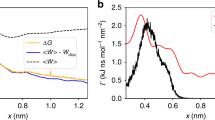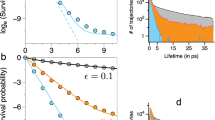Abstract
We have determined the structure of a metastable disulphide isomer of human insulin. Although not observed for proinsulin folding or insulin-chain recombination, the isomer retains ordered secondary structure and a compact hydrophobic core. Comparison with native insulin reveals a global rearrangement in the orientation of A- and B-chains. One face of the protein's surface is nevertheless in common between native and non-native structures. This face contains receptor-binding determinants, rationalizing the partial biological activity of the isomer. Structures of native and non-native disulphide isomers also define alternative three-dimensional templates. Threading of insulin-like sequences provide an experimental realization of the inverse protein-folding problem.
This is a preview of subscription content, access via your institution
Access options
Subscribe to this journal
Receive 12 print issues and online access
$189.00 per year
only $15.75 per issue
Buy this article
- Purchase on Springer Link
- Instant access to full article PDF
Prices may be subject to local taxes which are calculated during checkout
Similar content being viewed by others
References
Anfinsen, C.B. Principles that govern the folding of protein chains. Science 181, 223–30 (1973).
Kuwajima, K. The molten globule state as a clue for understanding the folding and cooperativity of globular-protein structure. Proteins 6, 87–103 (1989).
Kim, P.S. & Baldwin, R.L. Intermediates in the folding reactions of small proteins. Annu. Rev. Biochem. 59, 631–60 (1990).
Roder, H. Structural characterization of protein folding intermediates by protonmagnetic resonance and hydrogen exchange. Meth Enzymol. 176, 446–73 (1989).
Weissman, J.S. & Kim, P.S. Kinetic role of nonnative species in the folding of bovine pancreatic trypsin inhibitor. Proc. natn. Acad. Sci. U.S.A. 89, 9900–9904 (1992).
van Mierlo, C.P., Kemmink, J., Neuhaus, D., Darby, N.J. & Creighton, T.E. 1H NMR analysis of the partly-folded non-native two-disulphide intermediates (30–51,5–14) and (30–51,5–38)in the folding pathway of bovine pancreatic trypsin inhibitor. J. molec. Biol. 235, 1044–61 (1994).
van Mierlo, C.P., Darby, N.J., Keeler, J., Neuhaus, D., & Creighton, T.E. Partially folded conformation of the (30-51) intermediate in the disulphide folding pathway of bovine pancreatic trypsin inhibitor. 1H and 15N resonance assignments and determination of backbone dynamics from 15N relaxation measurements. J molec. Biol. 229, 1125–46 (1993).
Miranker, A., Robinson, C.V., Radford, S.E., Aplin, R.T. & Dobson, C.M. Detection of transient protein folding populations by mass spectrometry Science 262, 896–900 (1993).
Baker, D. & Agard, D.A. Kinetic versus thermodynamics in protein folding Biochemistry 33, 7505–7509 (1994).
Silen, J.L. & Agard, D.A. The α-lytic protease pro-region does not require a physical linkage to activate the protease domain in vivo. Nature 341, 462–464 (1989).
Mottonen, J. et al. Structural basis of latency in plasminogen activator inhibitor-1 Nature. 355, 270–273 (1992).
Carr, C.M. & Kim, P.S. A spring-loaded mechanism for the conformational change of influenza hamagglutinin. Cell 73, 823–832 (1993).
Bullough, P.A., Hughson, F.M., Skehel, J.J. & Wiley, D.C. Structure of influenza haemagglutinin at the pH of membrane fusion Nature 371, 37–43 (1994).
Sieber, P.S. et al. Synthesis and biological activity of two disulphide bond isomers of human insulin: [A7–A11,A6–B7-cystine] and [A6–A7,A11–B7-cystine] insulin (human). Hoppe-Seyler's Z. Physiol. Chem. 359, 113–123 (1978).
Brown, H., Sanger, F. & Kitai, R. The structure of pig and sheep insulins. Biochem. J. 60, 556–565 (1955).
Chan, S.J., Keim, P. & Steiner, D.F. Cell-free synthesis of rat preproinsulins: Characterization and partial aminoacid sequence determination. Proc. natn. Acad. Sci. U.S.A. 73, 1964–1968 (1976).
Steiner, D.F., Cunningham, D., Spigelman, L. & Aten, B. Insulin biosynthesis: evidence for a precursor. Science 157, 697–700 (1967).
Tang, J.G. & Tsou, C.L. The insulin A and B chains contain structural information fior the formation of the native molecule. Biochem. J. 268, 429–435 (1990).
Oas, T.G. & Kim, P.S. A peptide model of a protein folding intermediate. Nature 336, 42–48 (1988).
Baker, E.N. et al.. The structure of 2 Zn pig insulin crystals at 1.5 Å resolution. Phil. Trans. R. Soc. Lond. B319, 369–456 (1988).
Hua, Q.X., Shoelson, S.E., Kochoyan, M. & Weiss, M.A. Receptor binding redefined by a structural switch in a mutant human insulin. Nature 354, 238–241 (1991).
Bowie, J.U., Luthy, R. & Eisenberg, D.A. Method to identify protein sequences that fold into a kown three-dimensional structure. Science 253, 164–170 (1991).
Hendlich, M. et al. Identification of native protein folds amongst a large number of incorrect models. The calculation of low energy conformations from potentials of mean force. J. molec. Biol. 216, 167–180 (1990).
Overington, J., Donnelly, D., Johnson, M.S., Sali, A. & Blundell, T.L. Environment-specific amino acid substitutions tables: Tertiary templates and predictions of protein folds. Prot. Sci. 1, 216–226 (1992).
Derewenda, U. et al. The X-ray analysis of the single chain B29-A1 peptide-linked insulin molecule: a completely inactive analogue. J. molec. Biol. 220, 425–433 (1991).
Wüthrich, K. NMR of proteins and nucleic acids (Wiley, New York, 1986).
Bundi, A. & Wüthrich, K. 1H-NMR parameters of the common amino avid residues measured in aqueous solutions of the linear tetrapeptides H-Gly-Gly-X-L-Ala-OH. Biopolymers 18, 285–298 (1979).
Havel, T.F. An evaluation of computational strategies for use in the determination of protein structure from distance constraints obtained by nuclear magnetic resonance. Prog. Biophys. molec. Biol. 56, 43–78 (1991).
Chothia, C., Lesk, A.M., Dodson, G.G. & Hodgskin, D.C. Transmission of conformational change in insulin. Nature 302, 500–505 (1983).
Eisenberg, D. & McLachlan, A.D. Solvation energy in protein folding and binding. Nature 319, 199–203 (1986).
Novotny, J., Bruccoleri, R. & Karplus, M. An analysis of incorrectly folded protein models. Implications for structure predictions. J. molec. Biol. 177, 787–818 (1984).
Novotny, J., Rashin, A.A. & Bruccoleri, R.E. Criteria that discriminate between native proteins and incorrectly folded models. Proteins 4, 19–30 (1988).
Cooke, R.M. et al. The solution structure of echistatin: evidence for disulfide bind rearrangement in homologous snake toxins. Prot. Engng. 5, 473–477 (1992).
Hober, S., Forsberg, G., Palm, G., Hartmanis, M. & Nilsson, B. Disulfide exchange folding of insulin-like growth factor I. Biochemistry 31, 1749–1756 (1992).
Miller, J.A. et al. Oxidative refolding of insulin-like growth factor 1 yields two products of similar thermodynamic stability: A bifurcating protein-folding pathway. Biochemistry 32, 5203–5213 (1993).
Hober, S., Hansson, A., Uhlen, M. & Nilsson, B. Folding of insulin-like growth factor I is thermodynamically controlled by insulin-like growth factor binding protein. Biochemistry 33, 6758–6761 (1994).
DiMarchi, R.D. et al. Synthesis of a fast-acting insulin based on structural homology with insulin-like growth factror I in: Peptides: Proceedings of the Twelfth American Peptide Symposium (Smith, J. A., & Rivier, J. E., Eds.) 26–28 (ESCOM Science Publishers B. V, Leiden, The Netherlands, 1992).
Owers-Narhi, L. et al. role of native disulfide bonds in the structure and activity of insulin-like growth factor I (IGF-I): genetic models of protein-folding intermediates″. Biochemistry 32, 5214–5221 (1993).
Cooke, R.M. Harvey, I.S. & Campbell, I.D. Solution structure of human insulin-like growth factor 1: a nuclear magnetic resonance and restrained molecular dynamics study. Biochemistry 30, 5484–91 (1991).
Sali, A., Shakhnovich, E. & Karplus, M. How does a protein fold? Nature 369, 248–251 (1994).
Baldwin, T.O., Ziegler, M.M., Chaffotte, A.F. & Goldberg, M.E. Contribution of folding steps involving the individual subunits of bacterial luciferase to the assembly of the active heterodimeric enzyme. J. biol. Chem. 268, 10766–72 (1993).
Kitagawa, K., Ogawa, H., Burke, G.I., Chan & Katsoyannis, P.G. Critical role of the A2 amino acid residue in the biological activity of insulin: [2-glycine-A] and [2-alanine-A]-insulins. Biochemistry 23, 1405–1413 (1984).
Markussen, J. Single-chain des-(B30) insulin. Int. J. peptide prot. Res. 26, 70–77 (1985).
Kobayashi, M. et al. Receptor binding and negative cooperativity of a mutant insulin, [LeuA3]-insulin. Biochem. biophys. Res. Comm. 137, 250–257 (1986).
Mirmira, R. & Tager, H.S. Role of the phenylalanine B24 sidechain in directing insulin interaction with its receptor. J. biol. Chem. 264, 6349–6354 (1989).
Casaretto, M. et al. Shortened insulin with enhanced in vitro potency. Biol. Chem. Hoppe-Seyler 368, 709–716 (1987).
Chance, R.E. et al. The production of human insulin using recombinant DNA technology and a new chain recombination procedure in: Peptides: Proceedings of the Seventh American Peptide Symposium (eds. Rich, D. H., and Gross E., ) 721–728, (Pierce Chemical Co., Rockford, IL, USA 1981).
Hubel, R.E. Insulin-like growth factors I and II. Eur. J. Biochem. 190, 445–62 (1990).
Bi, R.C., Dauter, Z., Dodson, E., Dodson, G., Giordano, F. & Reynolds, C. Insulin structure as a modified and monomeric molecule. Biopolymers 23, 391–395 (1984)
Dai, J.-B. Lou, M.-Z. You, J.-M. & Liang, D.-C. Refinement of the structure of despentapetide (B26-B30) insulin at 1.5 Å resolution. Scientia. sin. 30 (1), 55–65 (1987).
Author information
Authors and Affiliations
Rights and permissions
About this article
Cite this article
Hua, QX., Gozani, S., Chance, R. et al. Structure of a protein in a kinetic trap. Nat Struct Mol Biol 2, 129–138 (1995). https://doi.org/10.1038/nsb0295-129
Received:
Accepted:
Issue Date:
DOI: https://doi.org/10.1038/nsb0295-129
This article is cited by
-
Identification of Lysine Misincorporation at Asparagine Position in Recombinant Insulin Analogs Produced in E. coli
Pharmaceutical Research (2019)
-
Characterization and optimization of two-chain folding pathways of insulin via native chain assembly
Communications Chemistry (2018)
-
A minimized human insulin-receptor-binding motif revealed in a Conus geographus venom insulin
Nature Structural & Molecular Biology (2016)
-
Biosynthetic engineered B28K–B29P human insulin monomer structure in water and in water/acetonitrile solutions
Journal of Biomolecular NMR (2013)
-
Recombinant A22G–B31R-human insulin. A22 addition introduces conformational mobility in B chain C-terminus
Journal of Biomolecular NMR (2012)



